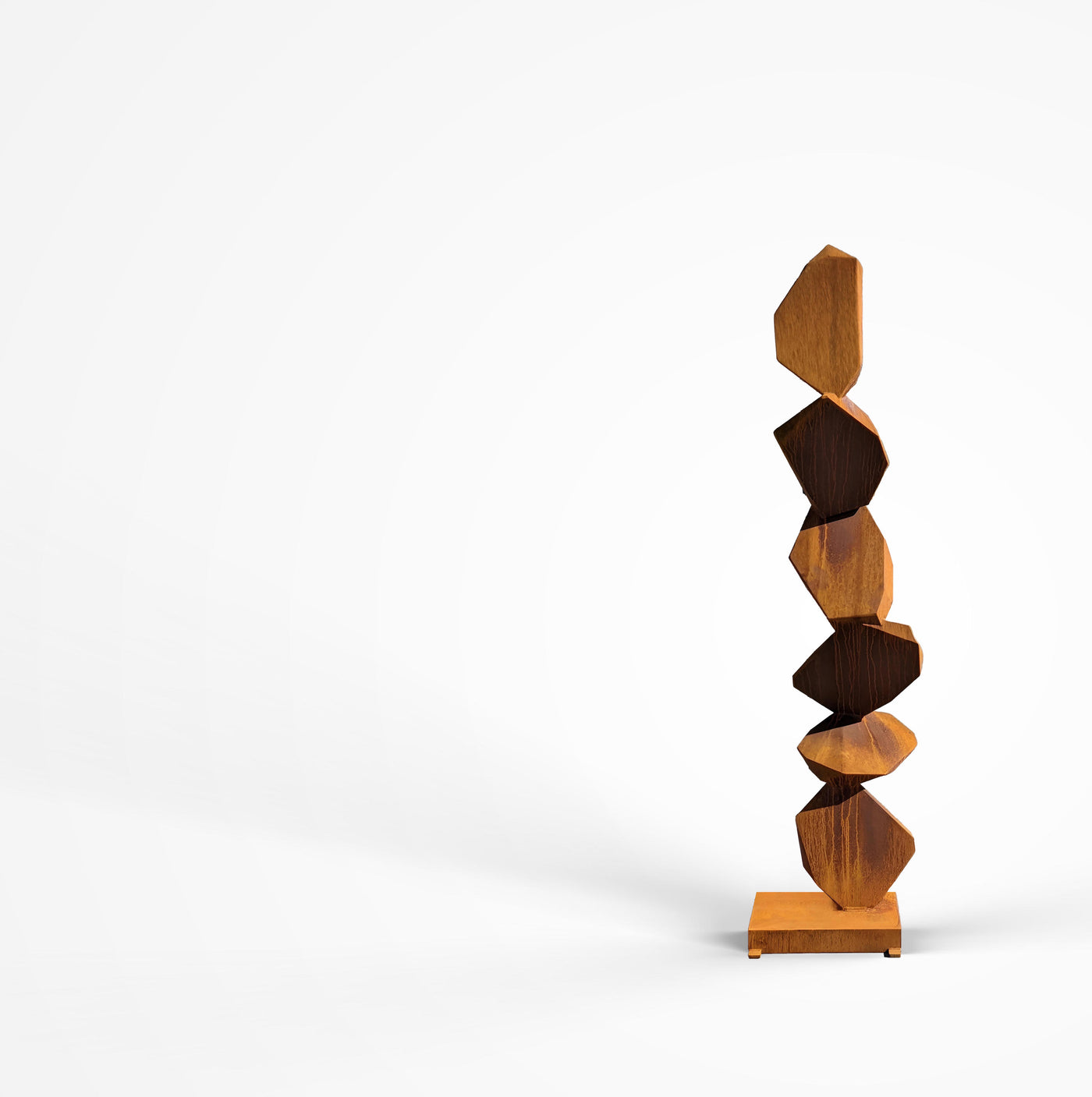Andrew Paul Wood: Ben Pearce, 'Future Ancients'
“Stones are mute teachers; they silence the observer, and the most valuable lesson we learn from them, we cannot communicate.” — Johann Wolfgang von Goethe
The above is the guiding inspiration for Ben Pearce’s exhibition. Stones are mute witnesses; they, of course, don’t speak. But they tell us much from their mineral composition, location, and the way nature has moulded them. They are symbols of permanence, solidity, and a tempting screen to project our own fears and desires upon. As Wittgenstein observed, “of which we cannot speak, thereof we must remain silent”. Pearce’s sculptures likewise must remain silent, redoubtably solipsistic, but they still have something to say, and their means of expression is the paradox of contradictory form.
The sculptures in Corten steel – an alloy developed to eliminate the need for painting, forming a rusty patina on exposure to weather – are monolithic, angular, minimalist and brutalist. Rather than feeling industrial, however, they feel like handwork, human, personal and individual. The emergent properties of their personality and softness become apparent on closer sustained viewing. Their monumentality is a kind of vanitas urging us to consider our own smallness and vulnerability as they loom gigantic overhead. There’s something very earthy in that rust-red hue, the colour of a weathered meteorite, the iron in the blood.
This is a significant departure from the subtle intimacies and delicate situational wit of Pearce’s previous work. These new works have more in common with the robust monumentality of modernism, of Antony Gormley, Caro, and Smith, Donald Judd, Phyllida Barlow, Barbara Hepworth, Richard Serra, and Henry Moore. It is work deeply grounded in art history that works both with and against form authentic to materials. Like triple rooted Yggdrasil, the world tree of Norse myth, it anchors itself in three sacred wells – in this case, the real, the metaphor, and the dream. As art historian Rosalind Krauss wrote of Caro, which seems entirely apposite for Pearce’s new sculptures, he “rendered the human form not as it looked from the outside, but how it felt from the inside, with its relationships subjectively conditioned.”
The philosopher Arthur Schopenhauer writes in the first volume of The World As Will And Representation, that while we only experience things outside ourselves as mediated representations rather than the thing itself, we experience the our own bodies as an object, a representation, and as the striving ‘will’ that exists beyond the shadow of representation. It is a unique experience to the individual, the inscape simultaneous with the flesh seen in the mirror. Art is often an abstract way of getting around the contingency of language, for expressing the ineffable. The body, in Pearce’s transformative vision, is not an object or matter, but a place, an experience at the intersection of the physical, the event, the conceptual, and the imaginable.
If Michelangelo painted like a sculptor, and Bernini sculpted like a painter, Pearce is probably somewhere in the middle translated into a postmodern context. The rock forms are chiselled away, and then fully realised as a physical object by Pearce himself, as sole maker, welding the rock shapes together, deliberately hiding any trace of this construction. The digital, the virtual, therefore forms another layer of Pearce’s sculptures. Gormley’s chunky, vaguely-cubist, rusty-red humanoid forms come to mind here. Figuration and material are deconstructed to let visual mass, form, colour and texture speak to us somewhere on the river of time.
The rock-like forms – again, a paradox, a mouldable material masquerading as an obdurate solid, metal pretending to be stone – rises like a guardian totem to become the genius loci of the gallery space, a counterpoint to the white cube. Each metal sculpture is chiselled as though it were stone, each different but in unity with each other. The closed, rock-like forms seek to liberate themselves into something open and infinite as they arch upward in DNA-like helices. Again, a paradox – metal becomes stone-becomes air, dynamic yet calm. These abrupt interventions into experienced space are reminiscent of the way Serra’s Tilted Arc functions in a public environment, casually interrupting and redirecting the flow of passage.
Perhaps that is the key to understanding these sculptures. They are elemental spirits, and sentient beings can be sensed within them as we read form as emotion, if not quite an articulate language. Through artifice we are reconnected to immanent, not transcendental, nature. Such sculpture stops you and forces you to consider the space to your, and its, environment. Even the most solid and permanent seeming thing in it is still transitional and in a process of metamorphosis. Pearce’s way-markers delineate the border between the primeval forest haunted by the ghosts of the ancestors, and the dream of a future as yet unborn.



